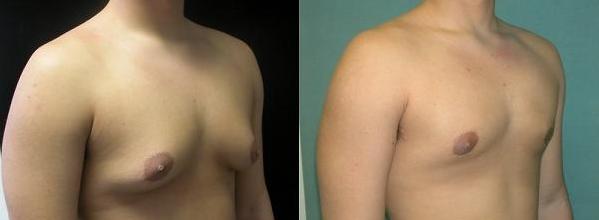Top 3 Treatments for Gynecomastia
The 3 Best Treatments for Gynecomastia–
Breast reduction procedures are normally associated with women. However, a condition known as gynecomastia, or male breast enlargement, affects men in surprisingly large numbers. Estimates indicate that more than 50% of men will experience some form of gynecomastia in their lifetime. In fact, some studies put the number considerably higher, suggesting that as many as 65 % of middle aged to elderly men may be affected by “man boobs”.
This condition can be the cause of great embarrassment for many men – since neither diet nor exercise are effective at reducing male breasts in most case. But the good news is that treatment for male breast enlargement now is available in many forms, including state-of-the-art non-surgical and minimally invasive treatment. Dr. Ali, board certified Oakland County plastic surgeon, specializes in the various treatments available to help men affected by gynecomastia live their lives with confidence.
In this article Dr. Ali discusses the three best treatments for reducing male breasts – surgery, liposuction and non-invasive CoolSculpting – all of which are available in our Oakland County surgical office and med spa.
Causes of Gynecomastia
Gynecomastia can affect one or both breasts, which can produce a lopsided effect. In teens, it is generally hormonal in nature, and likely will diminish with time as the hormone levels balance. However, if the condition persists, it may be a sign that something else is the cause, and may require medical intervention in the form of gynecomastia treatments.
Cancer is rarely the cause of male breast enlargement. However, it’s always a good idea to make an appointment with your doctor to rule out cancer, or for that matter, any other underlying health problems. Blood tests can generally determine if anomalies exist that indicate a need for medical intervention. The good news is that most common causes of gynecomastia are not serious or life threatening, and can be addressed cosmetically.
The actual underlying cause of gynecomastia can be the result of a variety of factors. Some of the more common causes are: changes in hormone levels; some medications, including some that are prescribed for heartburn, anxiety, some heart medications, and antibiotics; heavy alcohol consumption; the use of recreational drugs; some herbal products, such as tea tree and lavender; an overactive thyroid; kidney disease; and rapid or excessive weight gain.
Obviously, some of the causes of gynecomastia can be serious, so it is important for you to first make an appointment with your primary physician to rule out the need for medical intervention before setting out on a treatment program of any kind.
Treatments for Gynecomastia
After medical issues have been addressed or ruled out, we offer several excellent options to treat gynecomastia at AMAE Plastic Surgery and Medical Spa in Oakland County.
Mammoplasty (Breast Reduction) Surgery for Gynecomastia
The most common cause of gynecomastia is a hormonal imbalance, which can be treated with hormone therapy. It may require breast reduction mammoplasty surgery to reduce or remove the breast glandular tissue. In this procedure, Dr. Ali makes an incision in the skin and removes excess fat. Results are immediate and positive. Some side effects include some minimal scarring, and the recuperation and healing process requires some downtime. It is also important to note that most insurance companies will not cover mammoplasty surgery.
Liposuction for Gynecomastia
If a less invasive solution is desired, liposuction may be something to consider. Liposuction is generally safe and minimally invasive. Either a local anesthesia with sedation or a general anesthesia can be used. Two incisions are made, and are generally small, located on either side of the chest.
During liposuction in our Oakland County office, excess fat is surgically removed through a narrow surgical “straw” called a cannula. The cannula is attached to a liposuction machine and is moved around underneath the skin into the fat layer to remove the unwanted fatty deposits. As opposed to mammoplasty surgery, liposuction results in less bruising and bleeding, and the recovery is much faster.
The bruising and swelling from liposuction will be less than with mammoplasty surgery. In some cases there will be some swelling, soreness and occasional numbness. However, these symptoms should subside within a week or so.
CoolSculpting for Gynecomastia
CoolSculpting is not effective for “true” or “hormonal” gynecomastia. However, if your gynecomastia is caused by weight gain or certain other factors, CoolSculpting in our Oakland County medical spa may be very effective in reducing male breast fat deposits. In fact, CoolSculpting may be the best non-surgical treatment option for banishing male breast fat.
CoolSculpting involves a special machine that freezes the fatty areas of the breast. Over the next 2 to 3 months, these fat cells are eliminated naturally by the body, and the size of the breasts reduces permanently and dramatically. There are virtually no side effects, discomfort is minimal, and most men go back to work right after their CoolSculpting procedure is completed.
Gynecomastia Treatment Oakland County
Dr. Ali offers private and discreet consultations, and can assist you in determining the cause of your gynecomastia. Then, he will clearly explain your treatment options – so you can choose the male breast reduction procedure that is right for you.
If you live in the greater Oakland County area, give Dr. Ali a call at the AMAE Med Spa to set up an appointment.






